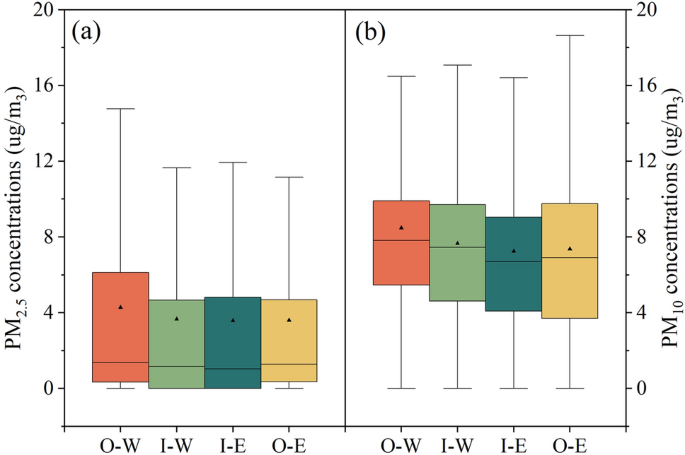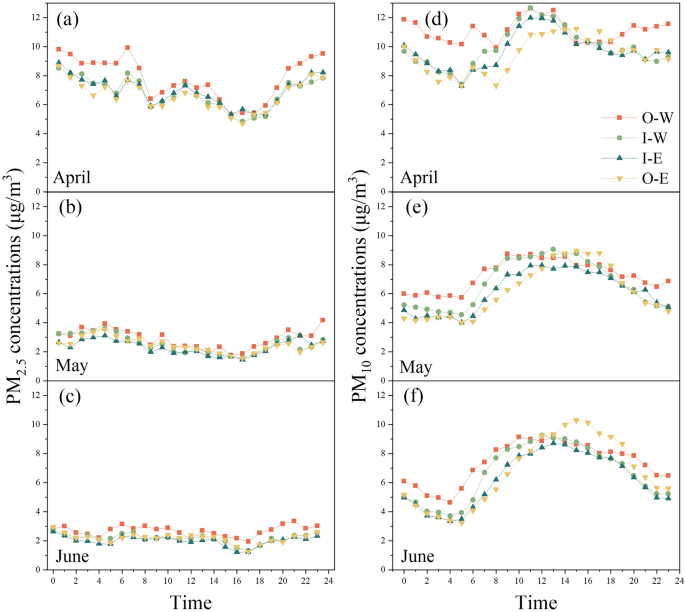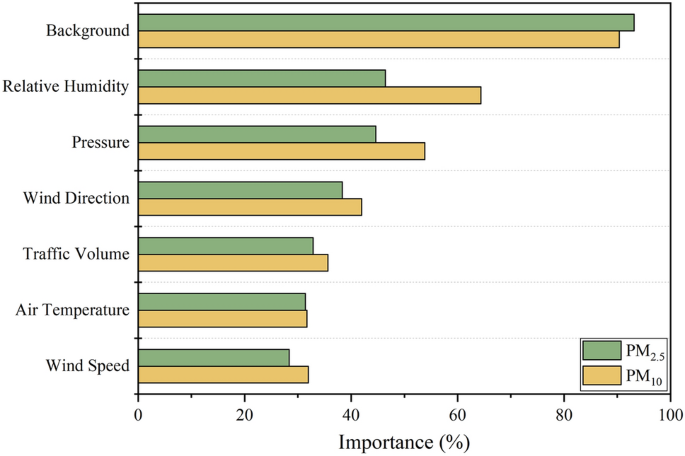Spatio-temporal distribution of PM
The four fixed stations inside and outside the park performed well from April to June and collected about 33,000 readings of PM2.5 and PM10 mass concentrations. Figure 3 presents the mean PM concentrations recorded at the four fixed monitor locations during the campaign. Despite lower traffic volumes observed on Fitzwilliam Street West, the highest PM2.5 and PM10 concentrations were observed at the O-W fixed air quality station on this road. The average monthly PM2.5 and PM10 concentrations collected were 15.0–18.8% (6.64–7.81 μg/m3 in April, 2.46–2.90 μg/m3 in May, and 2.18–2.69 μg/m3 in June) and 8.9–14.9% (9.46–11.11 μg/m3 in April, 6.23–7.32 μg/m3 in May, 6.73–7.39 μg/m3 in June) higher respectively, on Fitzwilliam Street West (O-W) compared to Fitzwilliam Street East (O-E). For the two stations inside the park, the monthly concentrations of PM2.5 collected by the station at the west side of the park (I-W) were up to 7.8% (2.00–2.17 μg/m3) higher than the one at the east side of the park (I-E), while PM10 concentrations were found up to 8.1% (6.22–6.77 μg/m3) higher on the west side (I-W).
Figure 4 shows the diurnal variations of calibrated PM2.5 and PM10 concentrations for different months in the study area from the four fixed stations (O-W, I-W, I-E, and O-E). The diurnal variations of PM2.5 concentrations presented a bimodal distribution pattern (Fig. 4a–c). The first peak in PM2.5 occurred between 04:00 and 08:00 (9.95 μg/m3 in April, 3.78 μg/m3 in May, and 3.17 μg/m3 in June), then it reduced and fluctuated until 17:00 (4.16 μg/m3 in April, 1.45 μg/m3 in May, and 1.04 μg/m3 in June). A second peak occurred between 20:00 and 00:00 (1.27 μg/m3 in April, 3.84 μg/m3 in May, and 3.24 μg/m3 in June). This pattern aligns with the diurnal cycle of PM2.5 observed in previous studies43,61. The increase in anthropogenic activities (e.g., vehicle exhaust emissions) and more intensive photochemical reactions in the morning lead to an increase in PM2.5 concentrations. Afterward, upward airflow attributed to the rising atmospheric boundary layer (ABL) and increased atmospheric instability promoted the upward dispersion of air pollutants, leading to a rapid decrease in PM2.5 concentrations in the afternoon42. In the evening, the stable boundary layer, increasing vehicle exhaust emissions and human activity (e.g., restaurants and bars) cause the gradual increase of PM2.5 concentrations61.
In contrast, the diurnal variations of PM10 concentrations presented significant unimodal distribution patterns (Fig. 4d–f). The PM10 concentration in the morning presented a decreasing trend and reached its lowest point at around 05:00 (6.67 μg/m3 in April, 3.84 μg/m3 in May, and 2.95 μg/m3 in June), then rapidly increased to its peak at around 12:00 (12.58 μg/m3 in April, 8.83 μg/m3 in May, and 9.48 μg/m3 in June). After that, the PM10 concentration decreased gradually. Similar to the study conducted in Korea, the peak of PM10 occurred with a 2-h delay after the peak hour45. Compared to PM2.5 concentrations, which are substantially influenced by atmospheric diffusion conditions and chemical transformations, coarser particles like PM10 exhibit shorter atmospheric residence times due to their inherent physical properties. Consequently, concentrations of PM10 are predominantly ascribed to local direct sources (e.g., urban road dust and sand), and generally remain elevated throughout the daylight hours, decrease during the night, and reach a minimum in the early morning24. It is notable that both PM2.5 and PM10 concentrations produced a peak at midnight during April, which may be linked to ongoing home heating at that time, causing higher emissions from fossil fuel combustion at night.
Figure 5 shows the overall diurnal changes of PM2.5, PM10 and the corresponding PM2.5/PM10 ratios during the monitoring period. The hourly mean PM2.5/PM10 ratios ranged from 0.28 to 0.66 during the day, with an average value of 0.45. In Europe, PM2.5/PM10 ratios have been observed to range from 0.39 to 0.74 in cities with high urbanization, which is consistent with the results of this study17. The ratios demonstrated an increase during the morning hours (prior to 6:00) and in the evening hours (after 18:00), with lower concentrations observed during mid-day. The peak PM2.5/PM10 ratio (Mean = 0.66, SD = 0.36) values was observed at 5:00, whereas the lowest value (Mean = 0.28, SD = 0.32) was typically observed at 17:00. Similar diurnal patterns of PM2.5/PM10 ratios were found in studies conducted in the UK and China22,43.
PM concentrations and corresponding influencing factors
Comparison of the influencing factors
This study employed three approaches including the Pearson correlation coefficient, Stepwise Regression, and Random Forest to explore the coupling effects of background concentrations, traffic volume, and meteorological parameters on ambient PM concentrations.
Table S4 presents the Pearson coefficients between PM2.5, PM10 concentrations, and their influencing factors. For PM concentrations, the most significant positive correlations were obtained with background concentrations, as background concentrations contribute significantly to local air quality42. In this case, PM2.5 and PM10 were strongly correlated (r = 0.825, p < 0.01) since the emission sources of PM are to some extent similar at this time of year i.e., vehicle exhausted sources, fuel burning and re-suspended road dust. Air temperature shows negative correlations with PM2.5 concentrations but positive correlations with PM10, which is consistent with results from Kassomenos et al. in winter conditions16. The Pearson correlation result shows negative correlations between PM10 and humidity while positive correlations between PM2.5 and humidity. This is due to increased PM deposition velocities attributed to high relative humidity, which is more significant for larger particles, while high relative humidity promotes the formation of secondary aerosols from gaseous precursors (e.g., SO2), found in PM2.5. A positive correlation between pressure and PM concentrations was found due to increased vertical air currents at ground level during low-pressure weather conditions, resulting in higher winds which accelerate the dispersion of pollutants44.
Stepwise Regression and machine learning model Random Forest were conducted to disaggregate the individual contributions of background concentrations, traffic volume, and meteorological parameters to local PM concentrations. The results of Stepwise Regression showed that PM concentrations were primarily affected by background concentrations, wind speed and traffic volume (Table S5). The contribution of background concentration to the measured PM2.5 and PM10 concentrations was 80.9% and 68.2%, respectively, making it the most dominant factor, consistent with the results of correlation analysis. In addition, Stepwise Regression indicated that surface pressure had a negligible effect on both PM2.5 and PM10 concentrations.
Random Forest was introduced to address the non-linear relationship between PM concentrations and other influential factors, and to further explore the contributions of background concentrations, local traffic volume, and meteorological parameters to local PM2.5 concentrations. The R2 value of the Random Forest model on training and test sets for PM2.5 and PM10 was 88.96% and 83.25%, respectively. The results demonstrated the reliability of the Random Forest model in understanding the influence of different factors on local PM2.5 concentrations.
As presented in Fig. 6, Random Forest model used the percentage increase in mean square error (%IncMSE) to quantify the relative importance of the background concentrations, traffic volume, and meteorological parameters to local PM concentrations. The results further confirmed the findings from stepwise regression that background concentrations were the most dominant factor in determining local PM concentrations, accounting for 93.2% and 90.4% of local PM2.5 and PM10, respectively. Following it were relative humidity and pressure, which contributed 46.4% and 44.6% to the PM2.5 concentration and 64.4% and 53.8% to the PM10 concentration, respectively. Different from the stepwise regression, the results of Random Forest indicated a low contribution rate of wind speed to local PM concentrations, explaining only about 28.4% of PM2.5 and 31.9% of PM10.
Background concentrations were identified as the most dominant factor by all three approaches—Pearson correlation coefficient, Stepwise Regression, and Random Forest—consistent with previous research findings4,42,62. Wind speed ranked as the second contributor by Pearson correlation coefficient and Stepwise Regression, but showed the lowest importance by Random Forest. Meanwhile, Pearson correlation and Random Forest indicated a high contribution of pressure, which ranked last in Stepwise Regression. The differences observed among the three approaches may be attributed to the fact that both Pearson correlation and Stepwise Regression assume a linear relationship between the dependent and independent variables when assessing variable importance63. Consequently, these models may exhibit bias and inaccuracy if non-linear relationships exist among the variables. In contrast, the Random Forest model can capture the complex interplay of multiple influencing factors on local PM2.5 concentrations, resulting in a more accurate and informative representation of their contributions.
Evaluating an evolving urban morphology on local air quality
Model validation
The PM2.5 and PM10 concentrations from the four fixed stations were collected during the period of manual traffic counts (morning peak, off-peak, and evening peak) on 27 April and 8 June. The modelled PM concentrations at the four locations fitted well with the fixed monitored data, with coefficient of determination (R2) of Pearson’s correlation of 0.93 and 0.80 for PM2.5 and PM10, respectively (Fig. S3). This study selected PM2.5 as the focus for ENVI-met modelling to investigate the impact of urban landscape on local air quality.
Changes in vegetation height on local PM2.5
Figure 7 presents the differences in ENVI-met results of PM2.5 concentrations between the no-vegetation scenario (No-VEG) and various vegetation heights of 7, 14 and 21 m, under the wind direction separately parallel and perpendicular to the main roads. The modelled distribution of PM2.5 concentrations, as well as the vertical plane visualization can be found in Fig. S4.
Comparison of the modelled distribution of PM2.5 concentrations at the seven receptors along the central axis of the park with different vegetation heights (7 m, 14 m, 21 m) to the no-vegetation model. The models were run under two wind directions: (a) perpendicular and (b) parallel to the main roads. The height at which data was collected is 1.5 m.
For a wind direction perpendicular to the roads, particularly with the west wind, the existing vegetation contributed to an increase in PM2.5 concentrations (7.4–14.4%) on the leeward road (West) outside the park, compared to the no-vegetation scenario. Conversely, this led to a decrease of 65.4–74.6% on the windward road (East), with the lowest vegetation (7 m in this case) presenting the best air quality conditions. With the perpendicular wind direction, the lowest vegetation (7 m in this case) most effectively improved air quality in the study area, with a reduction of 30.4% of the average PM2.5 concentrations (0.17–0.24 μg/m3).
For the wind direction parallel to the roads, the existing vegetation contributed to a decrease in average PM2.5 concentrations (1.52–10.45%) in the study areas. Specifically, the highest vegetation (21 m in this case) presented the greatest improvement in air quality over the study area in parallel wind conditions, decreasing average PM2.5 concentrations by 10.5% (0.19–0.21 μg/m3). For the footpaths on both roads, increased PM2.5 concentration occurred on the footpath near the buildings as the vegetation height increased. Meanwhile, the concentrations of PM2.5 on the park-side footpaths decreased with the height of the vegetation, as well as at locations within the park.
Previous studies showed that vegetation improves air quality more effectively when the wind direction is perpendicular to the road rather than parallel, consistent with the findings of this study6. Li et al. found that the optimal vegetation barrier heights for street canyons under perpendicular wind conditions are 1.1 m and 2.0 m, which are lower than the optimal heights determined in this study37. However, optimal vegetation heights are closely related to the morphology of buildings and vegetation, and CFD simulations can determine these optimal heights for specific locations15,37.
Changes in building heights on local PM2.5 concentrations
The differences in modelled PM2.5 concentrations at seven receptors resulting from changing the height of one building are shown in Fig. 8, and the concentration data with varying building heights, as well as the vertical plane visualization, can be found in Fig. S5.
Comparison of the modelled distribution of PM2.5 concentrations at the seven receptors along the central axis of the park for varying building heights (7 m and 21 m) to the initial 14 m model. (a1–a4) present the changes in the heights of the buildings W, N, E, and S under perpendicular wind, respectively. (b1–b4) present the changes in the heights of the buildings W, N, E, and S under parallel wind, respectively. The height at which data was collected is 1.5 m.
For wind direction perpendicular to the road, changes in building height on the leeward side (W) had the most significant impact on the PM2.5 concentrations on the leeward side (west) road. Decreasing the height of the building W by 50% (7 m) resulted in a decrease and increase in the traffic-emitted PM2.5 concentrations at the building (O-W1) and park (O-W2) sides of the footpath by 105.1% and 38.3%, respectively. Conversely, increasing the height of building W by 50% (21 m) resulted in an increase and decrease in the PM2.5 concentrations at O-W1 and O-W2, respectively, by 20.0% and 17.1% (Fig. 8a1).
Similarly, changes in building height on the windward side (E) had the impact on the PM2.5 concentrations mostly on the windward side (east) of the park. Decreasing the height of building E by 50% (7 m) resulted in an increase and decrease in the traffic-exhausted PM2.5 concentrations at the building (O-E1) and park (O-E2) sides of the footpath by 25.0% and 96.8%, respectively. And increasing the height of building E by 50% (21 m) resulted in a decrease and increase in the PM2.5 concentrations at O-E1 and O-E2, respectively, by 11.3% and 86.4% (Fig. 8a3). These changes in building height affected ground-level air pressure, which in turn modified the vortices above the road25. This mechanism either facilitates or inhibits the dispersion of traffic-emitted PM2.5 from the road onto the footpaths (Fig. S6). This morphology resembles wide street canyons, where previous studies have observed similar variations in pollutant concentrations with changes in building heights27,64.
In terms of the air quality on footpaths outside the park, increasing the leeward building’s height from 7 to 21 m resulted in a 25.3% increase in average PM2.5 concentrations (0.24–0.30 μg/m3). Increasing the height of the windward buildings from 7 to 21 m resulted in a 37.0% increase in average PM2.5 concentrations (0.27–0.37 μg/m3). Thus, reducing the heights of both the windward and leeward buildings is beneficial for improving the air quality on the footpaths and throughout the entire study area. However, reducing the height of leeward buildings can increase PM2.5 concentration inside the park. The impact of changing the windward building’s height had a negligible effect on air quality inside the park.
For wind conditions parallel to the road, changes in the height of the leeward buildings (S) had the greatest impact on overall PM2.5 concentrations in the study area, especially on the footpaths near the park, i.e., O-W2 and O-E2 (Fig. 8b). Setting the height of the leeward building (S) to 7 m and 21 m resulted in the lowest and highest average PM2.5 concentrations across all scenarios, at 0.19 μg/m3 and 0.27 μg/m3, respectively, representing a 30.9% difference. Taller buildings on the leeward side impede airflow into the study area, subsequently inhibiting PM2.5 dispersion. Adjusting the heights of the other three buildings has minimal effect on PM2.5 concentrations in the study area. Previous study found demonstrated that ground-level pollutant with wind direction parallel to the street axis are comparable to, or even higher than, those in perpendicular wind models47. For Fitzwilliam Park, where parallel winds are predominant, the height of leeward buildings is particularly important in local air quality.
This finding demonstrated that increasing building heights on specific sides of an urban square park can amplify air quality deterioration, depending on local meteorological conditions. This is potentially relevant to similar urban settings. In urban forms characterized by green spaces surrounded by buildings, as observed in the study area, if the predominant wind direction is perpendicular to the road, lowering the height of windward buildings is the optimal choice for improving air quality. Reducing the height of leeward buildings is also viable, but may slightly increase pollutant concentrations inside the park. Measures to optimize air quality inside the park, such as implementing taller vegetation, should be considered in this case. If the predominant wind direction is parallel to the road, minimizing the height of leeward buildings yields the best air quality in the city square park. For both wind directions, if high-rise buildings are necessary, it is recommended to position them along the side aligned with the wind direction to minimize air quality deterioration.







